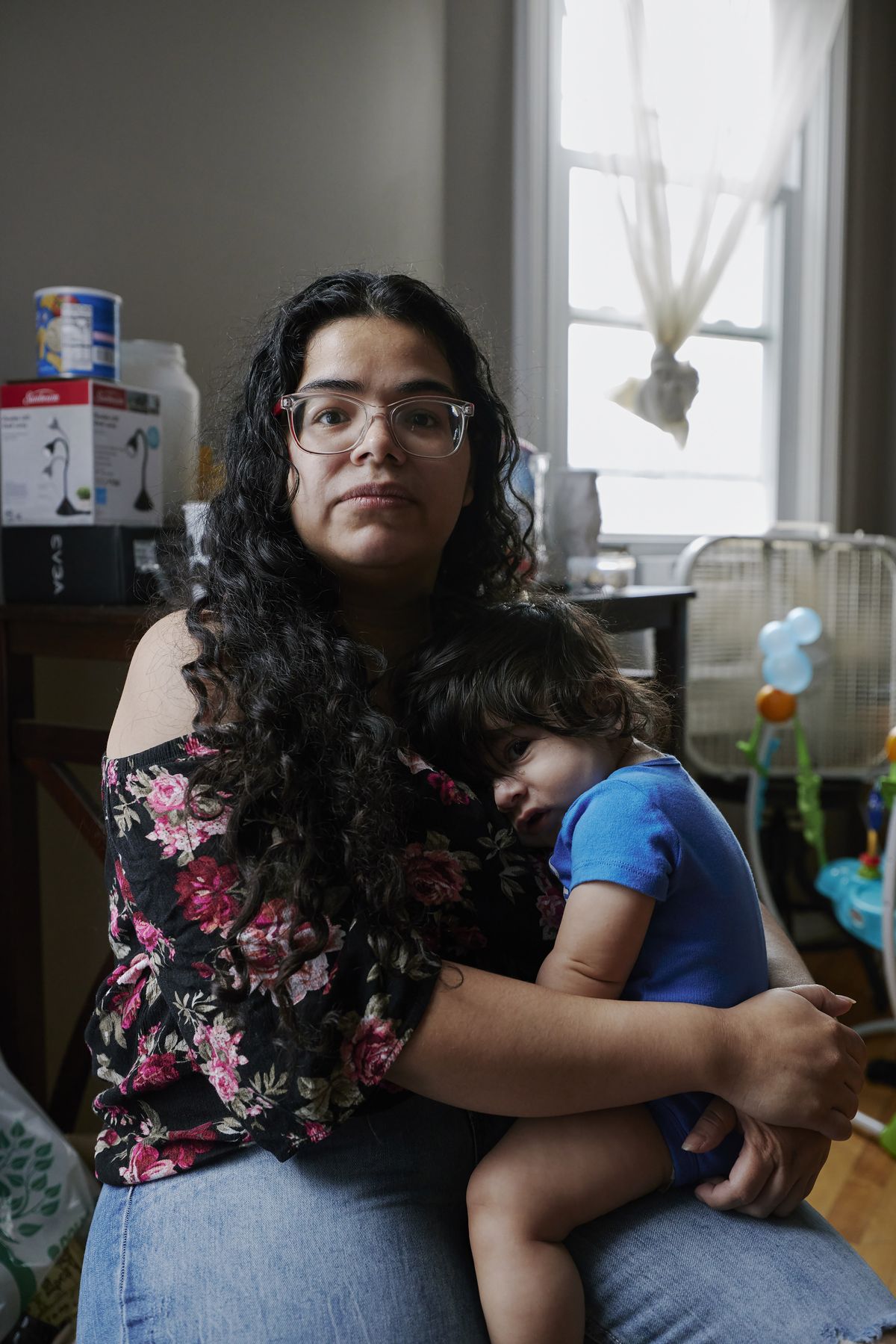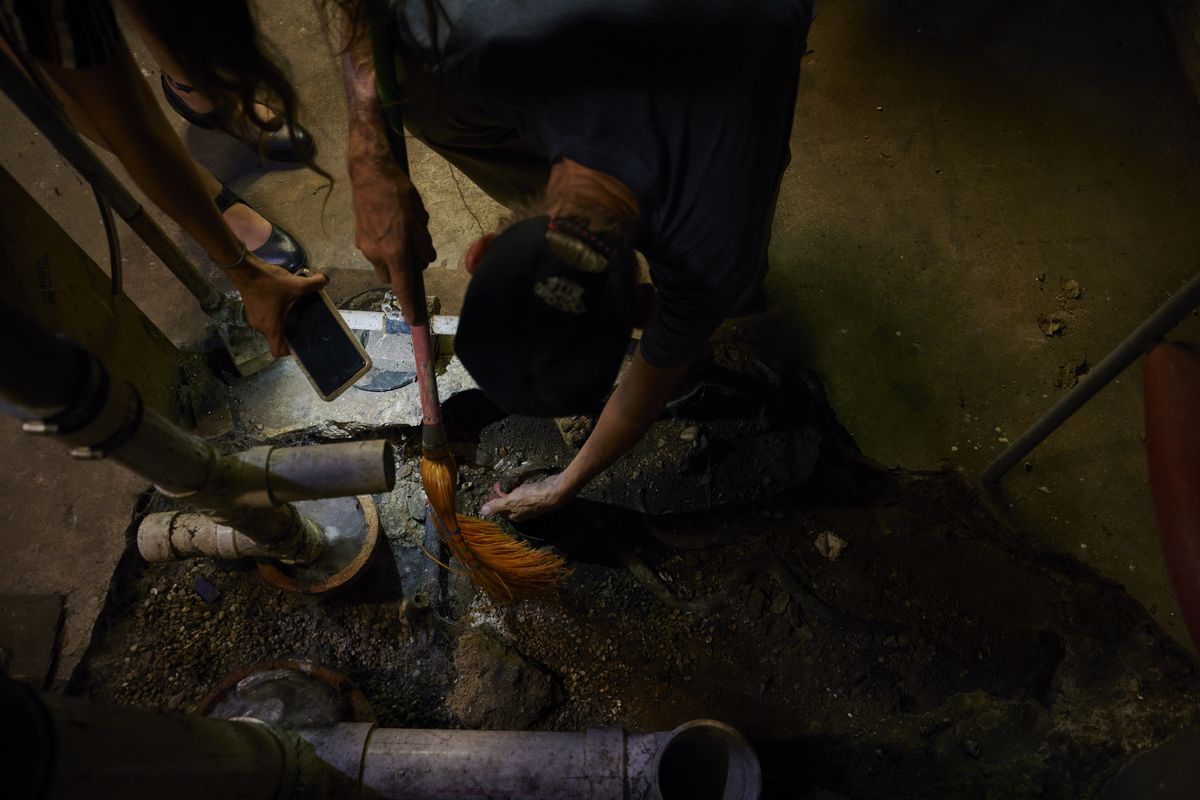Biden’s lead pipe removal plan faces hurdles
Crystal Vance and her father, David Vance, brush away debris to show the lead pipe in his basement in Chicago, Aug. 24, 2023. A string of unexpected impediments could hold up progress on President Joe Biden's promise to remove every lead pipe in America by 2031, officials say. (Mustafa Hussain/The New York Times) (MUSTAFA HUSSAIN)
CHICAGO — In her basement on the South Side of Chicago, Crystal Vance beamed a flashlight on the water source for her home: a rusted and leaking lead pipe.
Vance, 35, knows well the dangers of lead contamination. Her 5-year-old son tested for elevated levels of lead as a baby, something that still weighs on her conscience.
“I felt like my body was poisoned,” she said. “And I was feeding my kid this poison.”
But getting rid of the lead pipes snaking through her home — and through schools, offices, homes and day care centers around the country — has proved to be enormously complex, even after President Joe Biden promised early in his administration to remove every lead pipe in America by 2031.
The reasons are a mixture of financial, logistical and even semantic concerns, according to interviews with more than a dozen residents, environmental activists, and local and federal officials.
The way in which certain communities define the term “disadvantaged,” for example, affects whether they receive federal grants for lead pipe removal. Some residents also said they have struggled to get their landlords to start the removal process; homeowners, rather than tenants, must consent to the construction in some communities. Others said they are simply too overwhelmed with daily issues, such violent crime and paying bills, to invest in removing a piece of infrastructure they have lived with their entire lives.
And although advocates commend Biden for confronting the crisis head-on — securing nearly $27 billion in federal funding for clean water and lead pipe removal — they fear that a string of unexpected impediments could hold up progress for years to come.
Chicago — which has more than 400,000 lead pipes, the most in the country — offers a glimpse into how difficult it can be to implement such an ambitious, nationwide plan, advocates and city officials say.
Andrea Cheng, water-management commissioner of Chicago, said Illinois had set a timeline of 50 years to rid the city of lead pipes, well beyond the White House’s 10-year plan to remove every lead pipe in the country.
“I do not think anyone can do 409,000 in 10 years,” Cheng said. “As much as people want this, they also don’t want this in their neighborhood inconveniencing them.”
Robyn Patterson, a White House spokesperson, said the White House had made real progress in recent years.
“Our administration will continue to leverage every tool across federal, state and local governments to replace all lead pipes in America,” Patterson said.
Scientists agree that there is no safe level of lead in water and that even low levels have been shown to affect a child’s intelligence, learning ability and behavior. In the wake of the water contamination crises in Flint, Michigan, and other cities in recent years, Biden made eradicating lead pipes a centerpiece of his administration’s effort to address racial disparities in the United States.
“We’re replacing every single, solitary lead pipe in America — hear me?,” Biden told donors in Maryland in July before traveling for a speech in Chicago. Also this summer, Vice President Kamala Harris told donors at a campaign reception in Washington state that the administration was “on track to remove every lead pipe in America.”
There are signs of headway. Communities in Oregon, Washington, New Jersey and elsewhere have committed to getting rid of lead from water. Newark, New Jersey, replaced all 23,000 of its lead service lines with copper lines in 2021, in part by securing millions in bonds and adopting an ordinance that would allow it to replace lines without an owner’s consent.
Environmental advocates say Newark’s plan should be a model for the rest of the country.
A policy like New Jersey’s would help Sukky Bleck, a 27-year-old mother of two in Chicago, who was rebuffed by her landlord when she asked him to replace lead pipes. He questioned what the disruption would mean for his tenants living in the basement.
Bleck is still buying bottled water each week, hoping that cooking with the city’s water will not harm her newborn, who already has kidney issues.
As she held her baby inside her living room on a recent summer day, Bleck said she doubted the pipes would be removed anytime soon.
“For the White House, words sound nice, money is cool and if no one is following up on it on a constant basis,” she said, “nothing is getting done.”
(BEGIN OPTIONAL TRIM.)
Even those who do manage to get their lead pipes removed say the process is hardly smooth or swift.
Giuliana Ramirez, 46, who lives with her son and her parents on the East Side of Chicago, said it took two years to gather all the documents and get the city to process their water sample. Only then did the city’s lead-replacement program for low-income families approve her request.
In late August, after spending her life boiling water for cooking (which does not affect the lead content) and buying bottled water, she finally drank from the tap without a concern.
Growing up, Ramirez said she and her family always took precautions to not drink the city’s water. But they always felt they had more pressing concerns.
“Especially in a low-income neighborhood,” Ramirez said. “You almost don’t have the privilege to worry about the outside superficial things.” Her family was focused on ensuring food was on the table each night and that they were all safe.
“You don’t even realize not having clean water is part of your safety,” Ramirez said.
Another roadblock to lead-pipe removal in Chicago is the way in which the money is allocated.
States and cities have broad discretion in how they dole out the money, although the Biden administration has required that nearly half of the funding go to disadvantaged communities in the form of grants.
That means cities could create programs that ask residents to pay only a minimal amount, if anything, to get their pipes removed.
But states have different ways of defining “disadvantaged communities.” In Illinois, a local government would only qualify if it served at most 25,000 residents. Chicago has more than 2.6 million.
And although Chicago does have a free program for low-income households, many residents said they earn too much to qualify but too little to start the process of removing the lead pipes themselves. The upfront costs for removing lead pipes could run as high as $26,000, Cheng said — a massive sum even if the government reimburses people.
The White House has recognized that the definition of a disadvantaged community has had an outsize impact on the allocation of federal funding. Officials have reached out to more than 25 states to revise their definition to ensure that grants made it to the most needy communities.
Most agreed to revise the definition, while others told federal officials they wanted to wait for the initial round of funding before making any changes, according to Biden administration officials who spoke on condition of anonymity to discuss the program. Illinois, too, has proposed a rule that would define a disadvantaged community by census data rather than population.
The administration will also require states to report their inventory of lead pipes by October 2024 and is expected to update a federal regulation that would strengthen requirements to remove lead pipes, particularly in underserved communities.
“We have updated the state allocations to ensure the lead funding goes to the places with most need,” Patterson said. “Driving this funding to the ground to ensure every American has clean and safe drinking water is an everyday focus for this administration.”
(END OPTIONAL TRIM.)
Federal and local officials acknowledged there is a funding shortfall to complete the task of replacing every lead pipe in the nation. Biden initially proposed $45 billion in the infrastructure bill for lead removal; that number was slashed to $15 billion for lead-pipe removal by the time the legislation got through Congress. (Another roughly $12 billion was included to ensure clean drinking water.)
For now, people such as Vance are looking for smaller fixes.
As she walked through her basement recently, trying to find a way to plug that leaking lead pipe, she and her father, David, discussed their options.
The leak was “minor” and they could hire a plumber to fix it for a couple hundred dollars, he said. His daughter reminded him that fixing the pipe would not stop the contaminated water from flowing through their household. The solution was to replace the entire pipe.
But money was an obstacle. The project, she estimated, would cost thousands of dollars.
“To put the burden on people already burdened enough with everything going on seems a bit extreme,” she said.
Weeks later, the lead pipe is still leaking in the basement. But after years of drinking the water from lead pipes, they recently bought a filter.
This article originally appeared in The New York Times.






